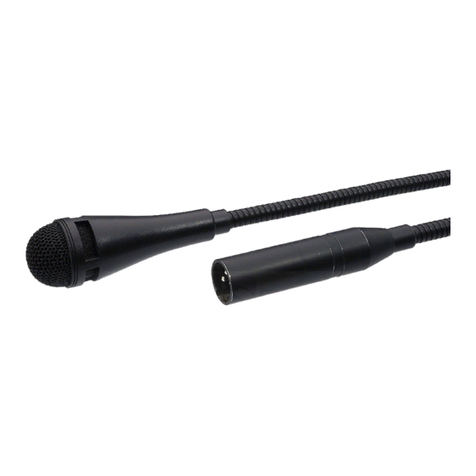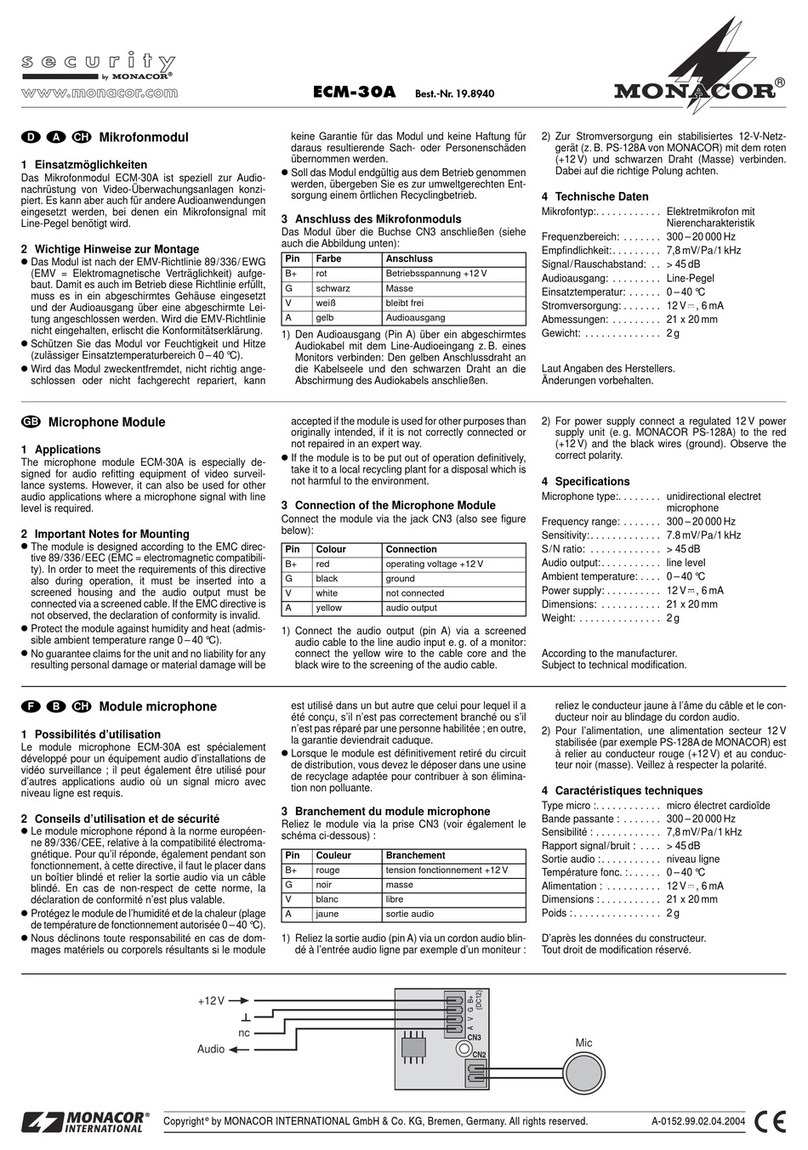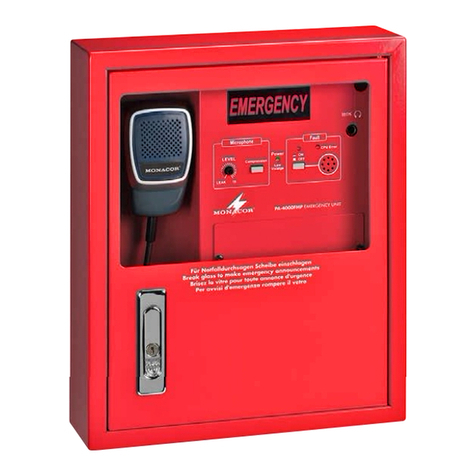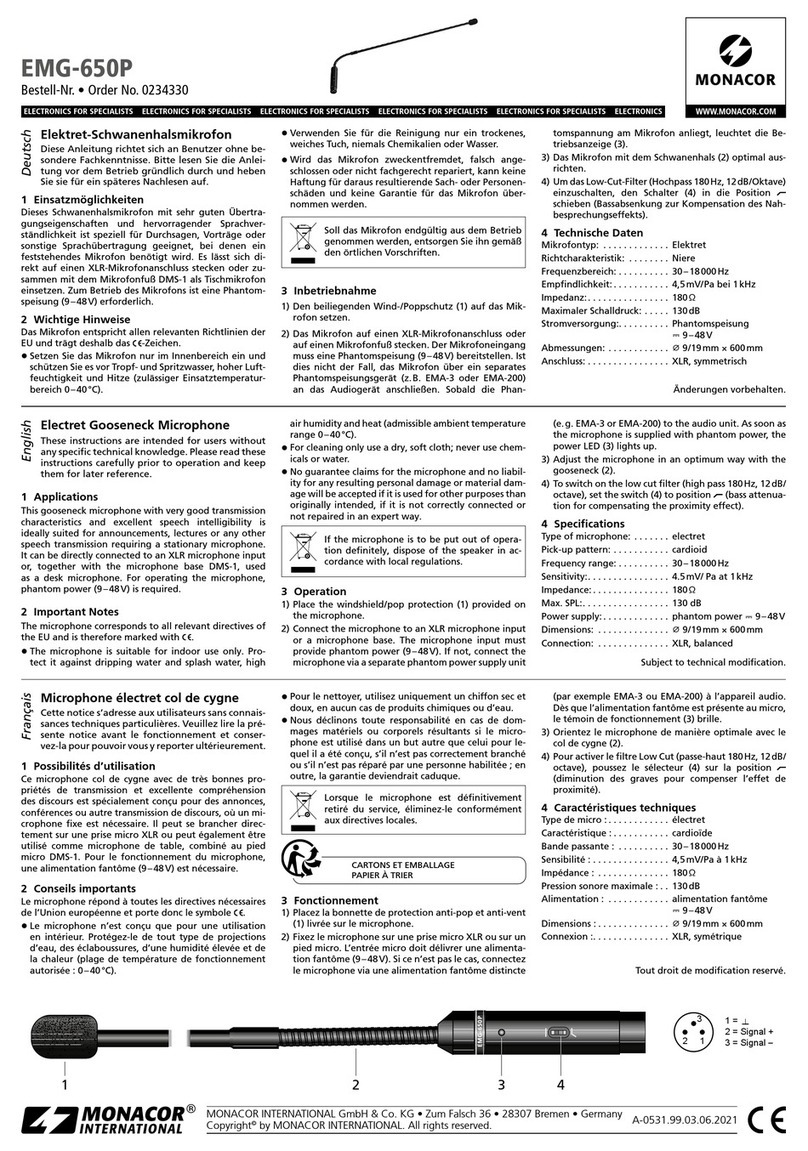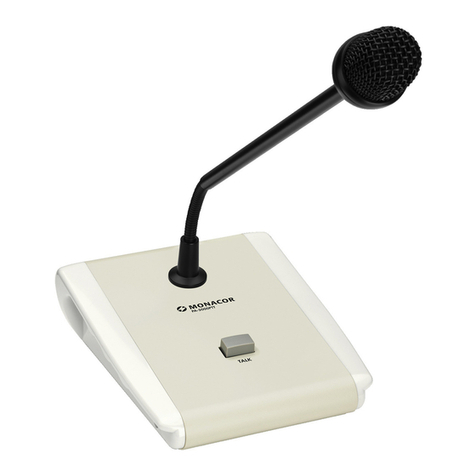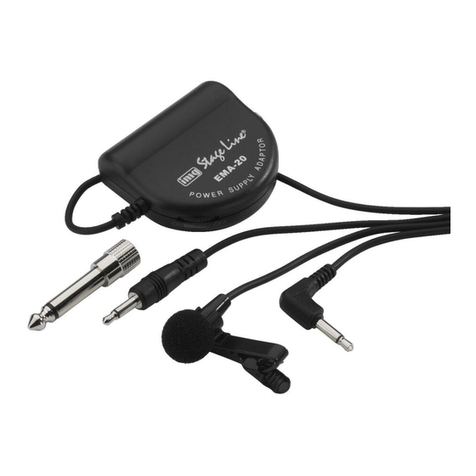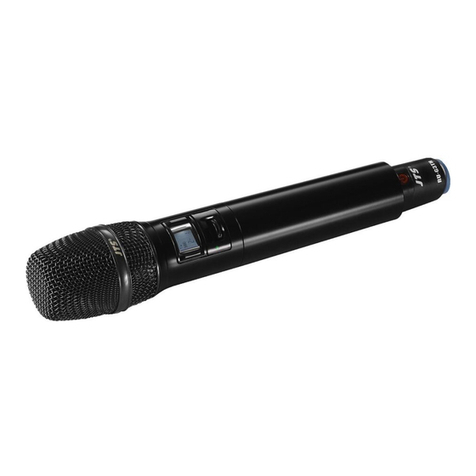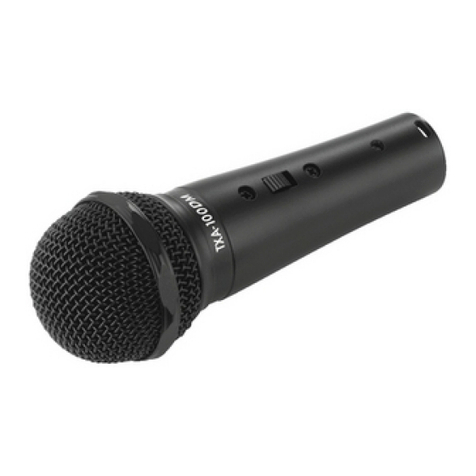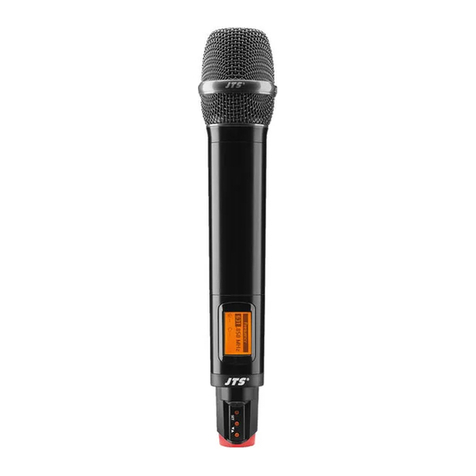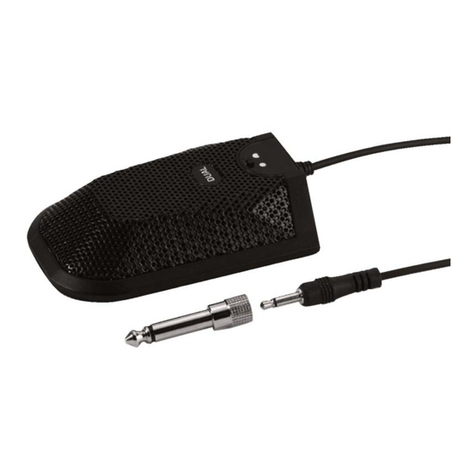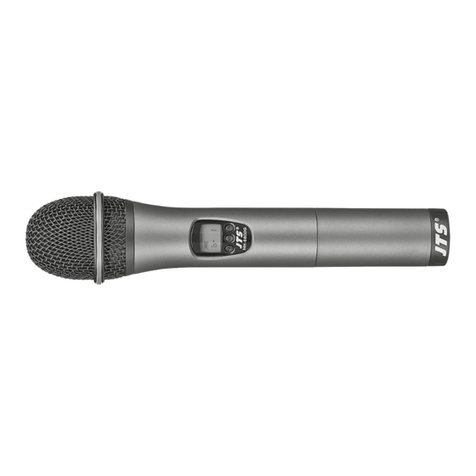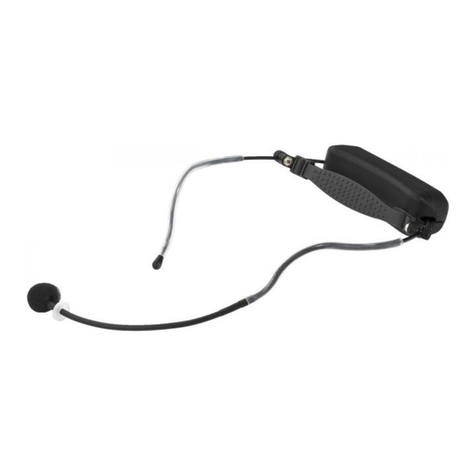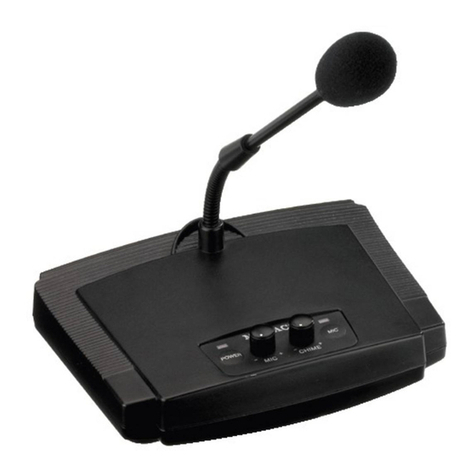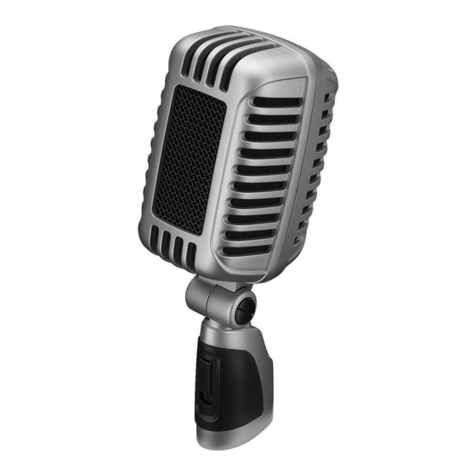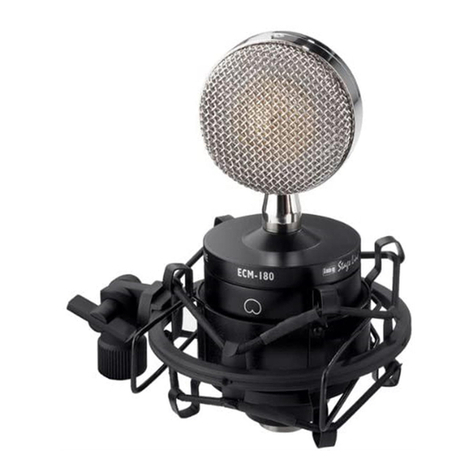
ELECTRONICS FOR SPECIALISTS ELECTRONICS FOR SPECIALISTS ELECTRONICS FOR SPECIALISTS ELECTRONICS FOR SPECIALISTS ELECTRONICS FOR SPECIALISTS ELECTRONICS
DM-2100 Bestell-Nr. •Order No. 23.1630
MONACOR INTERNATIONAL GmbH & Co. KG • Zum Falsch 36 • 28307 Bremen • Germany
Copyright©by MONACOR INTERNATIONAL. All rights reserved. A-0275.99.03.04.2016
1 12 2
3 3
ON
OFF
DM-2100
Mikrofon Dynamiczny
Niniejsza instrukcja przeznaczona jest dla użytkow-
ników nie posiadających doświadczenia oraz wie-
dzy technicznej. Przed rozpoczęciem użytkowania
prosimy o zapoznanie się z instrukcją i zachowanie
jej do wglądu.
1 Zastosowanie
Mikrofon dynamiczny jest przeznaczony do wokalu i
mowy na scenie, w teatrze, dyskotece, etc. W zesta-
wie znajduje się dodatkowo uchwyt, kabel mikrofo-
nowy oraz pokrowiec.
2 Informacje Dotyczące Bezpieczeństwa
Urządzenie spełnia wymogi norm obowiązujących w
Unii Europejskiej, jest zatem oznaczone symbolem .
•
Urządzenie przeznaczone jest do użytku jedynie
wewnątrz pomieszczeń. Należy chronić je przed
bezpośrednim kontaktem z wodą, przed działa-
niem wilgoci oraz wysokiej temperatury (dopusz-
czalna temperatura otoczenia pracy to 0–40 ºC).
•
Do czyszczenia należy używać jedynie czystego i
suchego kawałka materiału. Nie używać wody, ani
środków chemicznych.
•
Jeżeli urządzenie jest używane do innych niż
wskazane celów, jest nieprawidłowo podłączone,
obsługiwane w niewłaściwy sposób lub jest napra-
wiane przez niewykwalifikowane osoby, żadne
roszczenia gwarancyjne, ani roszczenia wynikające
z uszczerbku zdrowia lub zniszczenia mienia nie
będą akceptowane.
Jeżeli urządzenie nie będzie więcej używane
należy je utylizować zgodnie z przepisami
dotyczącymi ochrony środowiska.
3 Podłączanie
Mikrofon oraz kabel połączeniowy są symetryczne.
Jednak wtyk jack 6,3mm jest niesymetryczny (patrz
rysunek). Aby podłączyć mikrofon do wejścia syme-
trycznego, zastosować symetryczny kabel ze złączami
XLR (np. z serii MEC marki IMG STAGELINE).
1) Mikrofon należy podłączyć do wejścia mikro-
fonowego urządzenia (np.: miksera, wzmacnia-
cza,etc.).
2) Dokręcić uchwyt mikrofonowy do statywu za
pomocą śruby 16mm (5∕8”) i wsunąć mikrofon w
uchwyt.
3) Aby włączyć mikrofon należy przesunąć przełącz-
nik z pozycji “OFF” do “ON”.
4 Dane Techniczne
Charakterystyka
kierunkowa: � � � � � � � � � � � �kardioidalna
Zakres częstotliwości:� � � � �80 – 14 000 Hz
Czułość: � � � � � � � � � � � � � � �1,5 mV/Pa przy 1kHz
Impedancja: � � � � � � � � � � � �600 Ω
Dopuszczalna tempera-
tura otoczenia pracy: � � � � �0 – 40 °C
Wymiary: � � � � � � � � � � � � � �⌀52 mm × 180 mm
Waga:� � � � � � � � � � � � � � � � �260 g
Połączenia
Mikrofon: � � � � � � � � � � � �XLR, symetryczne
Przewód mikro� 6 m: � � � �XLR, symetryczny/
jack 6,3 mm, niesymetryczne
Z zastrzeżeniem możliwości zmian.
Micro Dinámico
Estas instrucciones van dirigidas a usuarios sin
ningún conocimiento técnico específico. Lea
atentamente estas instrucciones antes de fun-
cionamiento y guárdelas para usos posteriores.
1 Posibilidades de utilización
El micro dinámico se adapta particularmente a utili-
zaciones para cantes y discursos en escenarios, en tea-
tros y en discotecas, etc. Le entregamos también un
soporte de micro, un cable de conexión y una maleta
de transporte.
2 Consejos de seguridad y de utilización
Este micrófono corresponde a todas las Directivas
relevantes por la UE y por eso está marcado con .
•
El micrófono sólo está indicado para su uso en inte-
rior. Protéjalo contra proyecciones de agua, salpica-
duras, humedad elevada del aire y calor (tempera-
tura de funcionamiento admisible 0–40 °C).
•
Para limpiarlo, utilice un trapo seco y suave, en nin-
gún caso productos químicos o agua.
•
Rechazamos cualquier responsabilidad en caso de
daños materiales o corporales si el micro se utiliza
en otro fin para el cual ha sido fabricado, si no está
correctamente conectado o reparado por una per-
sona habilitada. Por estos mismos motivos el apa-
rato carecería de todo tipo de garantía.
Cuando el micro está definitivamente sa-
cado del servicio, debe depositarlo en una
fábrica de reciclaje de proximidad para con-
tribuir a una eliminación no contaminante.
3 Funcionamiento
El micro y el cable de conexión son simétricos, la toma
jack 6,35 es asimétrica (vea esquema). Para utilizar el
micrófono en una salida simétrica, utilice un cable
simétrico con conexiones XLR (p.ej. de la gama MEC
de IMG STAGELINE).
1) Conecte el micro vía el cable con la entrada micro
de un aparato audio (por ejemplo mesa de mezcla,
grabador, amplificador).
2) Atornille el soporte de micro sobre un pie de micro
con una rosca de 16mm (5∕8”) y coloque le micro
sobre el soporte.
3) Para conectar el micro, ponga el interruptor de
la posición “OFF” (micro apagado) en la posición
“ON”.
4 Características técnicas
Directividad:� � � � � � � � � � � �cardioide
Gama de frecuencias:� � � � �80 – 14 000 Hz
Sensibilidad:� � � � � � � � � � � �1,5 mV/Pa a 1 kHz
Impedancia: � � � � � � � � � � � �600 Ω
Temperatura func�: � � � � � � �0 – 40 °C
Dimensiones: � � � � � � � � � � �⌀52 mm × 180 mm
Peso:� � � � � � � � � � � � � � � � � �260 g
Conexiones
Micro:� � � � � � � � � � � � � � �XLR, sim�
Cable Low noise 6 m: � � �XLR, sim�/ Jack 6,35, asim�
Sujeto a modificaciones técnicas.
Microfono dinamico
Queste istruzioni sono rivolte a utenti senza
conoscenze tecniche specifiche. Vi preghiamo
di leggerle attentamente prima della messa in
funzione e di conservarle per un uso futuro.
1 Possibilità d’impiego
Il microfono dinamico è indicato in maniera ottimale
per applicazioni di canto e di lingua parlata sul palco-
scenico, a teatro, in discoteca ecc. Sono in dotazione
un supporto per il microfono, un cavo di collega-
mento e una custodia.
2 Avvertenze di sicurezza
Il microfono è conforme a tutte le direttive rilevanti
dell’UE e pertanto porta la sigla .
•
Usare il microfono solo all’interno di locali e pro-
teggerlo dall’acqua gocciolante e dagli spruzzi
d’acqua, da alta umidità dell’aria e dal calore (tem-
peratura d’impiego ammessa fra 0 e 40°C).
•
Per la pulizia usare solo un panno morbido, asciutto;
non impiegare in nessun caso prodotti chimici o
acqua.
•
Nel caso di uso improprio, di collegamento sba-
gliato o di riparazione non a regola d’arte non si
presta nessuna garanzia per il microfono e non si
assume nessuna responsabilità per eventuali danni
a persone o a cose.
Se si desidera eliminare il microfono defini-
tivamente, consegnarlo per lo smaltimento
ad un’istituzione locale per il riciclaggio.
3 Messa in funzione
Il microfono e il cavo di collegamento sono simmetrici
mentre il jack è asimmetrico (vedi figura). Se il micro-
fono deve essere usato con un ingresso bilanciato,
occorre usare un cavo bilanciato con contatti XLR
(p.es. della serie MEC di IMG STAGELINE).
1) Collegare il microfono con l’ingresso microfono
di un apparecchio audio (p.es. mixer, registratore,
amplificatore) per mezzo del cavo in dotazione.
2) Avvitare il supporto per il microfono su uno stativo
per microfoni dotato di filettatura 16mm (5∕8”) e
inserire il microfono nel supporto.
3) Per accendere il microfono spostare l’interruttore
da “OFF” (microfono spento) a “ON”.
4 Dati tecnici
Sistema: � � � � � � � � � � � � � � �cardioide
Gamma di frequenze:� � � � �80 – 14 000 Hz
Sensibilità: � � � � � � � � � � � � �1,5 mV/Pa a 1kHz
Impedenza:� � � � � � � � � � � � �600 Ω
Temperatura d’impiego: � � �0 – 40°C
Dimensioni: � � � � � � � � � � � �⌀52 mm × 180 mm
Peso:� � � � � � � � � � � � � � � � � �260 g
Collegamenti
microfono: � � � � � � � � � � �XLR, simm�
cavo low noise, 6 m: � � � �XLR, simm�/ jack 6,3 mm, asimm�
Con riserva di modifiche tecniche.
ItalianoEspañolPolski
Schema elettrico
Diagrama de circuito
Schemat obwodu

